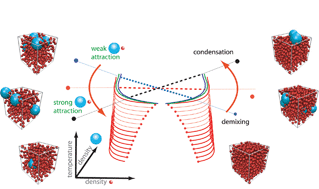Phase separation in binary eye lens protein mixtures
Abstract
Liquid–liquid phase separation occurs in young mammalian eye lenses and in concentrated solutions of isolated eye lens

* Corresponding authors
a
Institute of Theoretical Physics, Ecole Polytechnique Fédérale de Lausanne (EPFL), CH-1015 Lausanne, Switzerland
E-mail:
nicolas.dorsaz@a3.epfl.ch, giuseppe.foffi@epfl.ch
b Adolphe Merkle Institute, University of Fribourg, CH-1723 Marly 1, Switzerland
c Department of Physics, Rochester Institute of Technology, Rochester, NY, USA
d Physical Chemistry, Center for Chemistry and Chemical Engineering, Lund University, PO Box 124 SE-221 00 Lund, Sweden
Liquid–liquid phase separation occurs in young mammalian eye lenses and in concentrated solutions of isolated eye lens

 Please wait while we load your content...
Something went wrong. Try again?
Please wait while we load your content...
Something went wrong. Try again?
N. Dorsaz, G. M. Thurston, A. Stradner, P. Schurtenberger and G. Foffi, Soft Matter, 2011, 7, 1763 DOI: 10.1039/C0SM00156B
To request permission to reproduce material from this article, please go to the Copyright Clearance Center request page.
If you are an author contributing to an RSC publication, you do not need to request permission provided correct acknowledgement is given.
If you are the author of this article, you do not need to request permission to reproduce figures and diagrams provided correct acknowledgement is given. If you want to reproduce the whole article in a third-party publication (excluding your thesis/dissertation for which permission is not required) please go to the Copyright Clearance Center request page.
Read more about how to correctly acknowledge RSC content.
 Fetching data from CrossRef.
Fetching data from CrossRef.
This may take some time to load.
Loading related content
